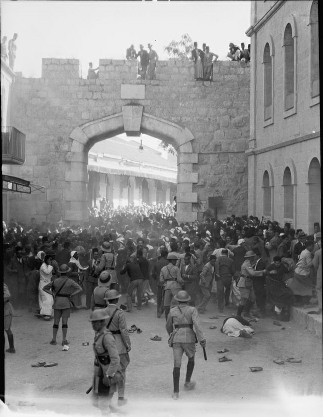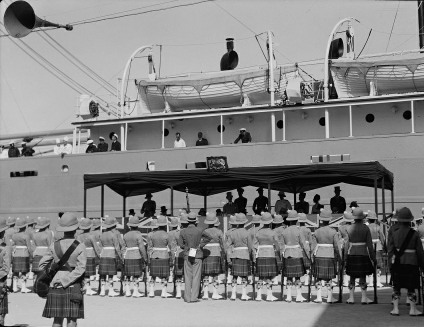Pages in Section 5

The 1933 Riots
ii.Dowbiggin's Report
iii. Re-organisation of the Palestine Police
iv. The Black Hand and Inspector Salim Basta
v. The 1933 Riots
vi. The Arlosorrof Case and Creation of the Dog Section
vii. King George V's Silver Jubilee
viii. The Black Hand re-emerges
Between 1930 and the beginning of 1933, life in Palestine seemed more stable but with the rise of the Nazis in Germany, Arab discontent over Jewish immigration and land purchases to Jews increased.
In the first eight months of 1933, 16,000 legal Jewish immigrants entered Palestine, compared with 10,000 in 1932 and 4,070 in 1931.
Although Haifa harbour was not officially opened until October, passenger boats from germany and Eastern Europe already used the port. The Jewish population of Haifa expanded rapidly. Hostile feeling against Jewish immigration was intensified by the knowledge that large numbers of Jews, estimated at some 10,000, had settled illegally. Matters were not helped by the Jewish Press reporting the proceedings of the Zionist Congress at Prague where the discussion on immigration created alarm amongst Arabs.
the Arab Press began a campaign against Jewish immigration towards the end of August. The papers alleged that the British Government was encouraging mass immigration of Jews to create a Jewish majority when a Palestinian Legislative Council was eventually introduced.
 The Arab Executive Committee planned a strike accompanied by a peaceful procession to take place from the Haram esh Sharif to the Government Offices in Jerusalem on 13th October. The High Commissioner banned the demonstration but the Arabs went ahead. British police officers stationed themselves at all the gates of the Old City. The demonstration began at noon led by members of the Arab Executive Committee. A British police officer, backed by a large police force, called on them to disperse. They refused, the situation looked ugly so police locked the gates of the old city to keep the rioters inside and the rest of Jerusalem safe. The photo on the left shows the riot in progress
The Arab Executive Committee planned a strike accompanied by a peaceful procession to take place from the Haram esh Sharif to the Government Offices in Jerusalem on 13th October. The High Commissioner banned the demonstration but the Arabs went ahead. British police officers stationed themselves at all the gates of the Old City. The demonstration began at noon led by members of the Arab Executive Committee. A British police officer, backed by a large police force, called on them to disperse. They refused, the situation looked ugly so police locked the gates of the old city to keep the rioters inside and the rest of Jerusalem safe. The photo on the left shows the riot in progress
A similar situation occurred in Jaffa later that month but with more disastrous consequences. The Arab Executive Committee planned to hold a political demonstration in Jaffa on October 27th. On October 25th the High Commissioner banned a political procession into the centre of Jaffa and as a further precaution announced an urban curfew for the next four nights.
Despite the ban Arab Executive Committee again decided to go ahead with the planned procession. The police protected public buildings and strategic points with barbed wire. They confiscated the weapons of everyone entering the city,stopped and searched cars.
On the day of the procession police gathered in the city square carrying 200 rounds of ammunition and special steel shields. Heavy detachments barred the approaches to the Central Square but were overcome by a surging mob of thousands of Arabs. These were led by the ports lightermen disgruntled at losing their livelihood to the new harbour in Haifa.
Police ordered the crowd to disperse. The crowd disobeyed. Mounted police attempted to charge, but the horses slipped on the asphalt. A constable, dragged from his horse was beaten with bottles and chairs taken from a cafe. Foot police made a baton charge to disperse the mob. From somewhere in the crowd shots were fired. The police in self-defence fired back. The massed Arabs fled, but many were crushed and trampled underfoot. Twenty people died that day.
After the retreat the police found an unexploded bomb.
That night, hundreds of police, assisted by the Trans-Jordan frontier force, supervised a curfew in Jaffa with a special guard to protect the Jewish suburb of Tel Aviv, which by this time contained 60,00 Jews, more than half the city's population.
Similar rioting occurred at Nablus, with a crowd attacking the railway station. The police there fired, killing one person.
 In Haifa, meanwhile, preparations were going ahead for a grand official opening of the new harbour. A special train had been organised to bring in 600 VIP's and a huge stand, furnished with seats borrowed from a local cinema had been erected for them in the main square. Even after the High Commissioner had imposed the four day curfew he had promised that the Harbour Celebrations, including the fireworks display would not be affected. However, after rioters, enraged by reports of events at Jaffa, had burnt down the VIP stand, stoned the police station, and attacked the railway station, the High Commissioner cancelled the VIP dinner and all celebrations. Instead the official harbour opening ceremony took place in front of a small group of local officials, heavily guarded by the military.
In Haifa, meanwhile, preparations were going ahead for a grand official opening of the new harbour. A special train had been organised to bring in 600 VIP's and a huge stand, furnished with seats borrowed from a local cinema had been erected for them in the main square. Even after the High Commissioner had imposed the four day curfew he had promised that the Harbour Celebrations, including the fireworks display would not be affected. However, after rioters, enraged by reports of events at Jaffa, had burnt down the VIP stand, stoned the police station, and attacked the railway station, the High Commissioner cancelled the VIP dinner and all celebrations. Instead the official harbour opening ceremony took place in front of a small group of local officials, heavily guarded by the military.
The photo on the right shows the diminished ceremony
In Jerusalem, another riot resulted from the Jaffa disturbance. A police station was attacked. Baton charges were useless. One policeman was stabbed so the police fired, killing two persons and wounding several others.